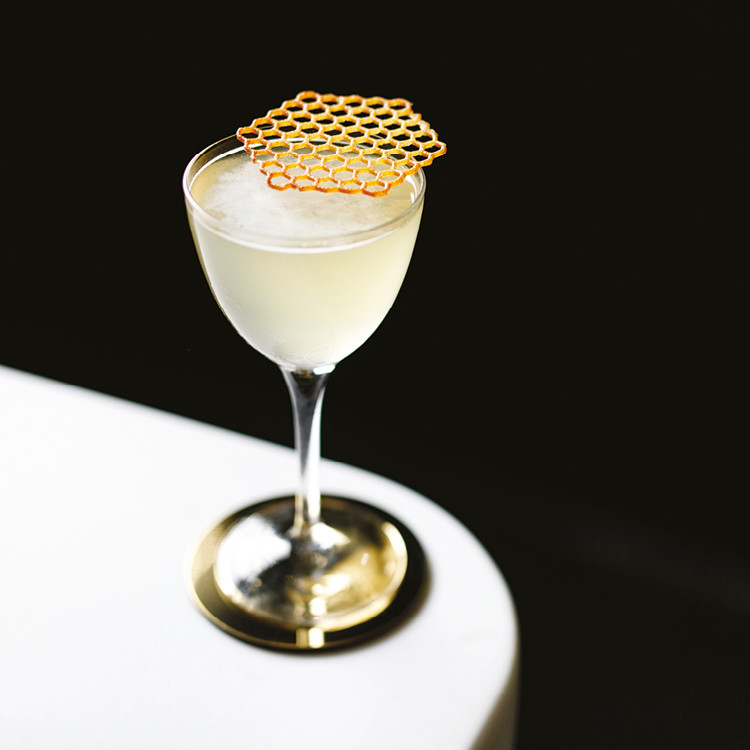
Rachel Hendry discovers the bars putting a firm focus on local produce to add exciting and unique elements to their drinks.
It can be hard to picture the seasonal abundance of local produce on the way to Lab 22 in Cardiff as you walk along the array of concrete, tarmac and pavement slabs that line the Welsh city centre. But perhaps that’s because I’m not thinking creatively enough. “I mean, there are bees on the roof of John Lewis,” Pajtim Tani Hasa, the owner of Lab 22, says as he points directly out of the bar’s window to the shopping unit opposite. “It doesn’t get much more local than that.”
For the past year and a half Hasa and his team have turned their attention to sourcing local ingredients for their award-winning menus. Their current menu, Theories + Frontiers – is the third in a trilogy and it was in the second iteration that they decided to pay more attention to what locality in cocktails means.
“It’s all about people,” head bartender Max Hayward says. “Everything we do revolves around our three pillars – accessibility, community and transparency. Everything should embody at least one of those in some way. And transparency and knowing where things come from and what goes in your drink, that ties in with so much locality. Locality actually instantly ticks all three of those boxes.”
At first locality seems like a focus on ingredients and ingredients only, but by fostering a local approach to its sourcing, Lab 22 has helped to grow a community in the process. Honey is sourced from the John Lewis roof with the help of local beekeeper Tim Wright, as well as from hives situated on the nearby Cardiff School of Pharmacy. The team work closely with local coffee roaster Uncommon Ground and have more recently established a close working relationship with local forager Chloe Newcomb Hodgetts, of Gourmet Gatherings.
“Locality is about being able to do more with local producers,” Hasa explains, “like taking the whole team to meet Chloe, our forager, and having them do a foraging day with her.”
In our conversation, Hasa, Hayward and bartender Ewan Grieve cite Little Red Door in Paris as an inspiration for the work they’re undergoing. Evergreen, Little Red Door’s 2023 menu, was a realisation of the bar’s farm-to-glass approach and serves as a stellar example of how prioritising local land and ingredients can enhance a menu, not diminish it.
“One of the best things about Wales is the produce we can grow,” Grieve says. “We have such a unique array of ingredients to play around with.”
“[It’s looking at] what’s in season and what’s about so we’re not getting papaya from Brazil when it’s currently peach season here and peaches are class,” Hayward adds. And it’s this uniqueness of land that can contribute towards the uniqueness of the final drink. Creation thrives on limitation, after all.
Flavour pairings
Of course, Lab 22 is not the only bar in the UK prioritising this approach. Gungho! in Brighton is a sustainable cocktail bar that prioritises seasonal British produce, local foraging and a sharp knowledge of flavour pairings to create cocktails of real distinction.
“When I first opened Gungho! in 2017 my main objective was zero waste – or as close as possible – which was an ideology from working at some very wasteful bars in the past,” says owner Julien Barnett.
“I found that using local produce when in season yielded much better flavours and I started foraging locally for more interesting ingredients. I love the challenge of playing with new flavours… and I think it’s great for my guests’ experience to go on that journey too, especially when we can pretty much guarantee they won’t ever have a drink like that again.”
Because that’s the thing – not only is locality a sustainable approach to bartending and community harnessing, it’s also a surefire way to guarantee uniqueness and individuality in recipes.
“I am really looking forward to the next drinks on our seasonal menu,” Barnett says, “which will be: locally foraged gooseberry and rose paired with scotch and Sipello aperitif, fennel fronds and crab apples paired with pine sap distillate, meadowsweet paired with strawberry eau de vie and Mermaid gin.” But the deliciously inventive nature of these drinks doesn’t just happen by accident, they’re a result of years of care and consideration that have gone into sourcing ingredients for a cocktail environment.
“When we first opened we were using freshly squeezed citrus and eggs… but I wasn’t happy with the solutions,” Barnett says. “So we came up with new ones, such as our hacked ‘lemon’ and ‘lime’ juice alternative, which uses a base of sour apple juice from a local orchard, and our discarded zest and distilled tonka foam – a mousse thickened with tree resins and suspended in NO2 to replace egg whites.”
Locality is an exciting topic to talk about, but it’s a vital one, too. Now, more than ever, it’s good to see the work of bars such as Lab 22, Gungho! and Little Red Door in providing the necessary examples that sustainability isn’t just a crucial option for the future, but a deliciously distinctive one as well.


